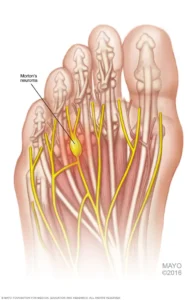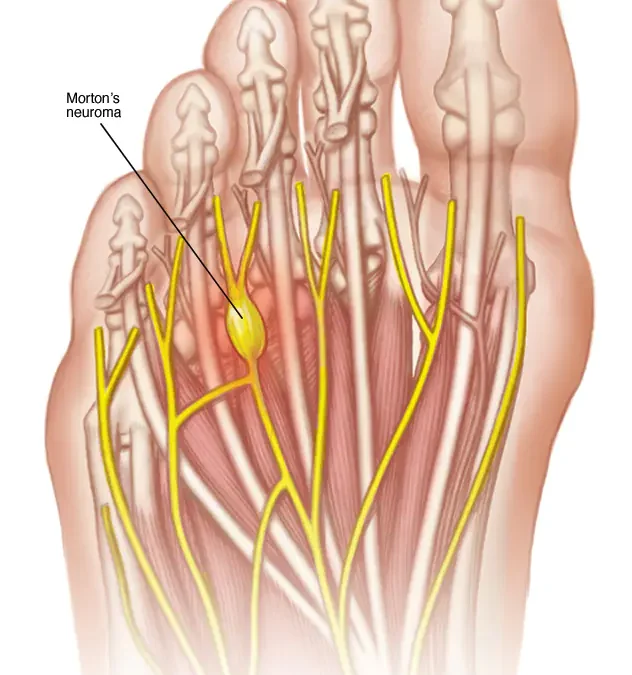Insights into Foot Neuromas (Morton’s Neuroma)
Foot neuroma’s are a fairly common condition. Some estimates are that they are found in up to 10% of the population. In this article we’ll discuss what is Morton’s Neuroma, some of the symptons, and how your providers at West Coast Podiatry can treat this foot condition.
What is a Morton’s Neuroma?
 Morton’s neuroma, also known as interdigital neuroma, is a painful condition that affects the foot, specifically the area between the third and fourth toes (although it can also occur between other toes). It involves a thickening of the tissue around one of the nerves leading to the toes.
Morton’s neuroma, also known as interdigital neuroma, is a painful condition that affects the foot, specifically the area between the third and fourth toes (although it can also occur between other toes). It involves a thickening of the tissue around one of the nerves leading to the toes.
Here’s how Morton’s neuroma typically develops: The nerves in the foot are responsible for transmitting sensory information to the brain. When the nerves become irritated or compressed, usually due to repetitive stress or pressure, they can thicken and form a neuroma. In the case of Morton’s neuroma, the most common location is between the third and fourth metatarsal bones in the foot.
The exact causes of Morton’s neuroma are not fully understood, but several factors may contribute to its development, including wearing tight or ill-fitting shoes (such as high heels or narrow-toed shoes), engaging in activities that put repeated stress on the feet (such as running or sports), foot deformities (such as bunions or hammertoes), or certain foot conditions like flat feet or high arches.
The most common symptom of Morton’s neuroma is pain or discomfort in the ball of the foot, typically localized between the affected toes. The pain may be sharp, burning, or tingling in nature. Some people may also experience a sensation of having a pebble or a lump under the foot. The pain is often exacerbated by walking, wearing tight shoes, or applying pressure to the area.
If you suspect you have Morton’s neuroma, it’s important to consult with a healthcare professional, such as a podiatrist or orthopedic specialist. They can perform a physical examination, review your symptoms and medical history, and potentially order imaging tests like X-rays or MRI scans to confirm the diagnosis.
Treatment for Morton’s neuroma typically begins with conservative measures, such as changing footwear to shoes with a wider toe box and lower heels, using orthotic devices or arch supports, and avoiding activities that worsen the symptoms. In some cases, corticosteroid injections may be recommended to reduce inflammation and alleviate pain. If conservative treatments fail to provide relief, surgical intervention may be considered to remove the neuroma or release pressure on the affected nerve.
It’s worth noting that the information provided here is not a substitute for professional medical advice, diagnosis, or treatment. If you suspect you have Morton’s neuroma or any other medical condition, it’s important to consult with a qualified healthcare professional for an accurate diagnosis and appropriate treatment.
What can cause Morton’s Neuroma?
The exact causes of Morton’s neuroma are not fully understood, but several factors are believed to contribute to its development. These factors include:
Footwear: Wearing tight, narrow, or high-heeled shoes can increase the risk of developing Morton’s neuroma. These types of footwear can compress the toes together and put pressure on the nerves, leading to irritation and thickening of the nerve tissue.
Foot deformities: Certain foot deformities, such as bunions, hammertoes, or flat feet, can alter the biomechanics of the foot and contribute to the development of Morton’s neuroma. These conditions can lead to instability, improper weight distribution, and increased pressure on the nerves.
Repetitive stress and overuse: Activities that involve repetitive stress on the forefoot, such as running, jogging, or participating in high-impact sports, can increase the likelihood of developing Morton’s neuroma. The repeated trauma and pressure on the nerves can result in irritation and thickening of the nerve tissue.
Footwear with inadequate support: Wearing shoes that lack proper arch support or cushioning can increase the risk of foot-related conditions, including Morton’s neuroma. Insufficient support can lead to excessive pressure on the forefoot and nerves, contributing to nerve irritation and thickening.
Gender and age: Morton’s neuroma is more common in women than men, possibly due to a higher prevalence of wearing high-heeled shoes. The condition also tends to occur more frequently in middle-aged individuals, although it can affect people of all ages.
It’s important to note that while these factors are associated with an increased risk of developing Morton’s neuroma, they do not guarantee its development. Some individuals may have no identifiable risk factors but still develop the condition, while others with multiple risk factors may never experience it.
If you suspect you have Morton’s neuroma or are concerned about your foot health, it is advisable to consult with a healthcare professional, such as a podiatrist or orthopedic specialist. They can evaluate your condition, discuss potential causes, and recommend appropriate treatment options.
How do we at West Coast Podiatry diagnose Morton’s Neuroma?
The diagnosis of Morton’s neuroma typically involves a combination of a physical examination, a review of your symptoms and medical history, and sometimes imaging tests. Here’s an overview of the diagnostic process:
- Medical history and symptom evaluation: Your healthcare provider will begin by discussing your symptoms and medical history. They will inquire about the nature of your pain, when it started, factors that exacerbate or alleviate the pain, and any relevant past foot conditions or injuries.
- Physical examination: A physical examination of the foot will be conducted to assess the affected area. Your healthcare provider will palpate the foot, applying pressure between the toes to elicit any pain or discomfort. They may also check for any visible foot abnormalities or signs of nerve irritation.
- Diagnostic tests: While imaging tests are not always necessary, they can be helpful in confirming the diagnosis or ruling out other conditions. Common imaging tests include:
-
- X-rays: X-rays can help rule out other conditions, such as stress fractures or arthritis, which may cause similar symptoms.
- Ultrasound: Ultrasound imaging can provide real-time images of the foot structures, including the nerves. It can help identify the presence of a neuroma and assess its size and location.
- MRI (Magnetic Resonance Imaging): MRI scans can provide detailed images of the foot and soft tissues, helping to visualize the neuroma and rule out other possible causes of your symptoms.
It’s worth noting that the diagnosis of Morton’s neuroma can sometimes be challenging, as the symptoms may overlap with other foot conditions. Therefore, it’s important to consult with a healthcare professional who specializes in foot disorders, such as a podiatrist or orthopedic specialist, to ensure an accurate diagnosis.
Remember, this information is not a substitute for professional medical advice. If you suspect you have Morton’s neuroma or any foot-related condition, it is recommended to seek the expertise of a qualified healthcare professional for an evaluation and appropriate treatment recommendations.
Does Morton’s neuroma ever fully resolve or go away?
Morton’s neuroma is a chronic condition that may not resolve on its own without appropriate treatment. However, the outcome and the duration of symptoms can vary from person to person. With proper management, many individuals experience significant relief from their symptoms and are able to effectively manage the condition.
- Conservative treatments are often the first line of approach and can be effective in relieving the symptoms of Morton’s neuroma. These may include:
- Footwear modifications: Wearing shoes with a wide toe box, low heels, and good arch support can help reduce pressure on the affected area and alleviate symptoms.
- Orthotic devices: Custom orthotic inserts or padding can help improve foot mechanics, reduce pressure on the neuroma, and provide cushioning.
- Medications: Nonsteroidal anti-inflammatory drugs (NSAIDs) may be recommended to help reduce pain and inflammation associated with Morton’s neuroma.
- Injection therapy: Corticosteroid injections can be used to reduce inflammation and provide temporary pain relief.
- Physical therapy: Stretching exercises and physical therapy modalities can help improve foot and ankle strength, flexibility, and overall biomechanics, potentially reducing symptoms.
If conservative treatments fail to provide relief, or if the neuroma is severe or persistent, surgical intervention may be considered. The surgical procedure typically involves removing the neuroma or releasing pressure on the affected nerve. Surgical treatment can be highly effective in relieving symptoms, but it is important to discuss the potential risks and benefits with a healthcare professional.
It’s important to note that early intervention and appropriate treatment can significantly improve outcomes for individuals with Morton’s neuroma. If you suspect you have Morton’s neuroma or are experiencing foot pain, it is recommended to consult with a healthcare professional, such as a podiatrist or orthopedic specialist, for an accurate diagnosis and personalized treatment plan. They can assess your specific condition and provide appropriate recommendations to manage your symptoms effectively.
How do we treat Morton’s neuroma at West Coast Podiatry?
The treatment options for Morton’s neuroma can be classified into conservative (non-surgical) approaches and surgical interventions. The specific treatment recommended will depend on the severity of symptoms, the individual’s overall health, and their preferences. Here are the common treatment options:
Conservative Treatment Options:
- Footwear modifications: Wearing shoes with a wide toe box, low heels, and adequate arch support can help relieve pressure on the affected area and reduce symptoms.
- Orthotic devices and shoe inserts: Custom-made orthotic devices or over-the-counter shoe inserts can provide support, improve foot mechanics, and reduce pressure on the neuroma.
- Medications: Nonsteroidal anti-inflammatory drugs (NSAIDs), such as ibuprofen, can help reduce pain and inflammation associated with Morton’s neuroma.
- Injection therapy: Corticosteroid injections can be administered directly into the affected area to reduce inflammation and provide temporary pain relief.
- Physical therapy: Specific exercises and stretches, as well as techniques like ultrasound or iontophoresis, may help improve foot mechanics, reduce nerve irritation, and alleviate symptoms.
- Padding and taping: Applying metatarsal pads or toe separators can help relieve pressure on the neuroma and provide symptom relief.
Surgical Treatment Options:
- Neuroma excision: In cases where conservative treatments have failed or the neuroma is severe, surgical removal of the neuroma may be recommended. This procedure involves removing the affected nerve segment. However, it’s important to note that this can result in permanent numbness in the affected area.
- Decompression surgery: This procedure aims to relieve pressure on the nerve by releasing surrounding structures, such as ligaments or nearby bones, which may be compressing the nerve.
The choice between surgical and conservative treatment options depends on various factors, including the severity of symptoms, response to conservative treatments, the impact on daily activities, and individual preferences. It’s essential to consult with a healthcare professional, such as a podiatrist or orthopedic specialist, to discuss the most suitable treatment plan based on your specific condition.
REMEMBER: The information provided here is for general knowledge and is not a substitute for professional medical advice from one of our providers at West Coast Podiatry. Please contact us today for an accurate diagnosis and personalized treatment recommendations.


